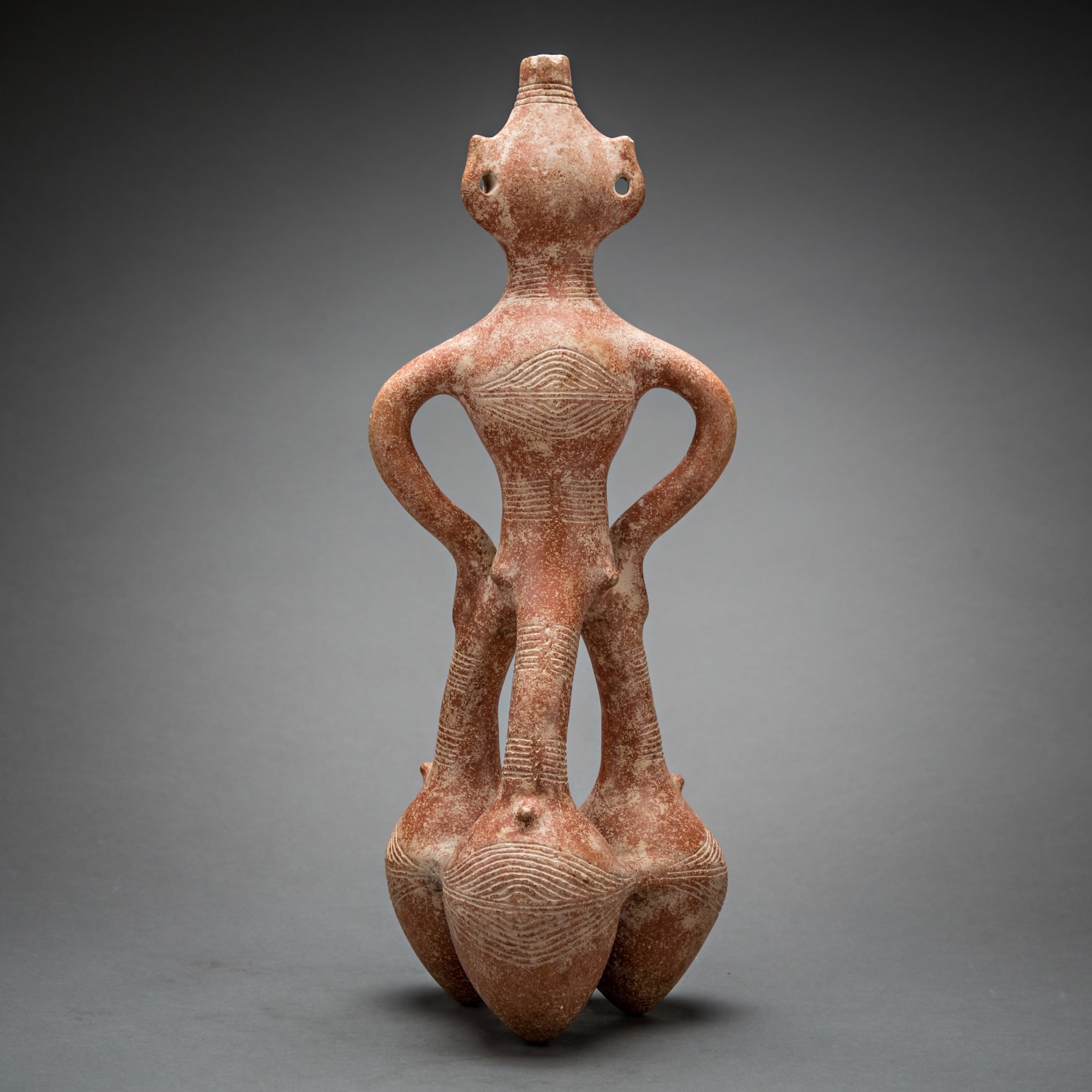Cypriot Bronze Age Antropomorphic Vessel, 1500 BCE - 900 BCE
Earthenware
42.3 x 15.7 cm
16 5/8 x 6 1/8 in
16 5/8 x 6 1/8 in
LO.1231
Further images
Red polished ware vessel in anthropoid form with incised markings over whole; trio of lower bodies, linked in the horizontal plane, form the feet and base of the vessel, their...
Red polished ware vessel in anthropoid form with incised markings over whole; trio of lower bodies, linked in the horizontal plane, form the feet and base of the vessel, their necks rising through the legs and fuse to enter base of a fourth jug forming body, before giving way to neck and head; narrow spout protrudes from top of head; crude, rather “ape-like” features moulded in a grimace, flanked by large, drilled ears; arms protrude laterally forming handles. This piece marks a period spanning from the Late Bronze Age (1650-1050 BCE) to the early Iron Age (1050- ACE 350). Red polished ware formed a dominant ware of the Cypriot Bronze Age. The clay was covered with red slip, which was then burnished to produce a high polish. Today, this shiny polish has survived, creating glinting highlights. Many of the pottery vessels found in the ancient tombs of Cyprus are adorned with representations of humans, animals, plants or inanimate objects. In this instance the vessel itself is transformed into a human. This piece takes the Cypriot process of pluralization – started at the beginning of the Bronze Age – to a zenith of complexity. Multi-bodied vessels were not uncommon during this period, however rarely take an animate form and when they do there is a clear bias toward animal-shapes, rather than human shapes, making this an exceptionally rare item. A great deal more work would have been involved in its production; from the offset it was clearly intended for an exalted status amid the retinue of funerary objects. The standard of finish is exceptional. The contours of the body exaggerated in one direction or another and relief elements applied to the surface, in this case, the face. Incised decoration is commonly seen on the surface of Red Polished Ware and are usually, as in this case, abstract patterns cut into the clay at the point when it is ‘leather hard’, before firing. After the incisions have been made they have been rendered more conspicuous by the addition of a white in-filling, making them stand out against the dark, red background. Human figures in ancient Cypriot art are not realistic representations of the human form, rather highly stylized and display deliberate modification of the human shape. Has been looked down on critics and art historians. Today, however a very different view prevails and it is generally agreed that these artists were not attempting to reproduce realistic shapes but rather the exploitation of a natural shape for symbolic purposes, which they achieved via schematization, stylization, stereotyping and abstraction.
The lack of similar vessels may be explained by the obstacle of how to present items as vessels rather than figurines. There is a small group of figures from the Middle Bronze Age that herald the new wave of human representations styles about to arrive in the Late Bronze Age. Long-eared figures. A tradition for vessel-shaped figures began in Early Bronze Age, where small human faces are placed as decorations on the rims, necks or handles of bowls. By a slight extension of this process, the vessel becomes a figure. This type of pottery is incredibly rare. Cf. The Art of Ancient Cyprus, Desmond Morris (Phaidon, Oxford, 1985) pp. 162-164.
The lack of similar vessels may be explained by the obstacle of how to present items as vessels rather than figurines. There is a small group of figures from the Middle Bronze Age that herald the new wave of human representations styles about to arrive in the Late Bronze Age. Long-eared figures. A tradition for vessel-shaped figures began in Early Bronze Age, where small human faces are placed as decorations on the rims, necks or handles of bowls. By a slight extension of this process, the vessel becomes a figure. This type of pottery is incredibly rare. Cf. The Art of Ancient Cyprus, Desmond Morris (Phaidon, Oxford, 1985) pp. 162-164.













